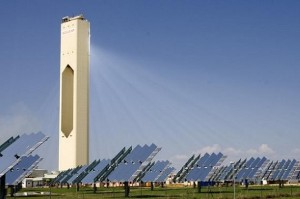 Abengoa Solar announced today that it has finalized $1.45 billion financing to build Solana, the world’s largest parabolic trough concentrating solar plant which will generate 250 net megawatts (MW). A parabolic trough is a type of solar thermal energy collector. Santiago Seage, CEO of Abengoa Solar, stated, “Solana is the first large scale CSP plant for Abengoa Solar in the U.S. and will be a key milestone for our development in this country as it allows us to strengthen our relationships with the local community as well as with the state and federal public authorities that have contributed notably to this project.” Abengoa Solar signed a power purchase agreement with Arizona Public Service Co, Arizona’s largest electric utility, to buy the energy produced by Solana for a period of 30 years.
Abengoa Solar announced today that it has finalized $1.45 billion financing to build Solana, the world’s largest parabolic trough concentrating solar plant which will generate 250 net megawatts (MW). A parabolic trough is a type of solar thermal energy collector. Santiago Seage, CEO of Abengoa Solar, stated, “Solana is the first large scale CSP plant for Abengoa Solar in the U.S. and will be a key milestone for our development in this country as it allows us to strengthen our relationships with the local community as well as with the state and federal public authorities that have contributed notably to this project.” Abengoa Solar signed a power purchase agreement with Arizona Public Service Co, Arizona’s largest electric utility, to buy the energy produced by Solana for a period of 30 years.
The plant will be located 70 miles southwest of Phoenix, near Gila Bend, Arizona. Solana will produce enough energy to serve 70,000 households and will prevent the emission of 475,000 tons of CO2 per year compared to a natural gas burning power plant. The construction and operation of Solana will bring many economic and environmental benefits to Arizona and will support the nation’s goals for energy independence through a “green” economy. Abengoa Solar estimates that the Solana project will create between 1,600 to 1,700 new construction jobs and over 85 permanent jobs. Approximately 98 percent of the jobs created by the project will be American jobs, primarily in Arizona, in addition to neighboring states. Furthermore, around 75% of the equipment and supplies required to build Solana will be manufactured in the U.S.
Solana will produce enough energy to serve 70,000 households and will prevent the emission of 475,000 tons of CO2 per year compared to a natural gas burning power plant. The construction and operation of Solana will bring many economic and environmental benefits to Arizona and will support the nation’s goals for energy independence through a “green” economy. Abengoa Solar estimates that the Solana project will create between 1,600 to 1,700 new construction jobs and over 85 permanent jobs. Approximately 98 percent of the jobs created by the project will be American jobs, primarily in Arizona, in addition to neighboring states. Furthermore, around 75% of the equipment and supplies required to build Solana will be manufactured in the U.S.
In late 2009 Abengoa Solar signed a power purchase agreement in California to supply electricity generated by a 250 MW net CSP trough plant located in the Mojave Desert, 100 miles northeast of Los Angeles. The company also has several projects under development in the Southwest.







